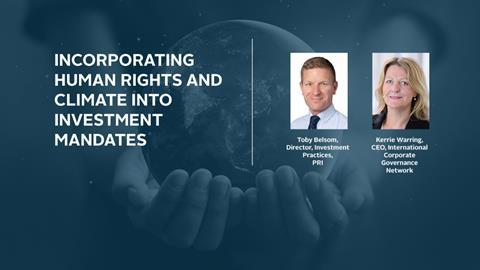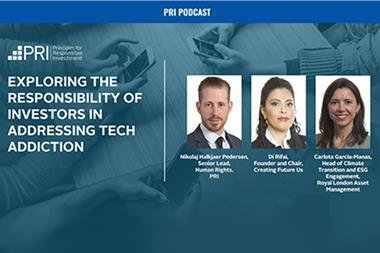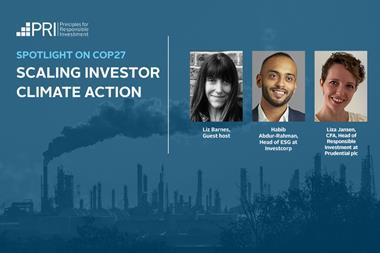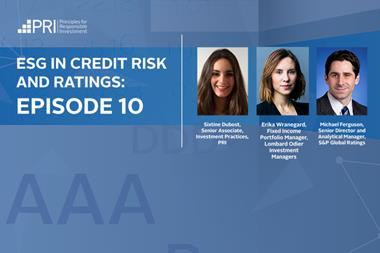Incorporating human rights and climate into investment mandates
With Toby Belsom, Director, Investment Practices, PRI and Kerrie Warring, Ceo, International Corporate Governance Network
Note: The Principles for Responsible Investment podcast is designed to be heard. If you are unable to do this, this transcript offers an insight into the episode.
Transcripts are generated using a combination of speech recognition software and human transcribers, and may contain the occasional error. Please check the corresponding audio before quoting in print.
Subscribe to the channel via Apple podcasts, Spotify, or wherever you listen to your podcasts.
Toby Belsom
Welcome to this PRI podcast on using investment mandates to implement responsible investment commitments and policies. My name is Toby Belsom. I’m a Director at PRI. My team oversees the development of tools and guides that are aimed to help asset owners to ensure responsible investment is at the core of the relationship between asset owners and investment managers.
I’m really pleased to be joined by Kerrie Warring. Kerrie is the CEO at International Corporate Governance Network (ICGN). Under her tenure. The organisation is now recognised as the world’s leading governance organisation, representing investors who manage just over 70 trillion in US dollars and coming from over 45 different countries. They’ve recently published an extensive and excellent update on ICGN’s model mandate. And that’s going be the focus of our discussion during this podcast. Welcome, and thank you for joining us, Kerrie.
Kerrie Warring
Thanks so much, Toby. It’s a pleasure to be with you. We are long-time friends of the PRI and very much respect all of the great work that you’re doing, looking forward to the chat.
Toby Belsom
So, let’s start with a kind of easy question. Maybe you could outline exactly what the model mandate is and the role it plays in the relationship between asset owners and investment managers.
Kerrie Warring
The model mandate was introduced in 2012 and it was introduced really in response to levels of scepticism around the world, around the degree to which investors were ably holding companies to account following the great financial crisis. So a number of ICGN members got together under the ICGN shareholder responsibilities committee, and they developed a document to provide asset owners with a way to align the interest of their fund managers with their own obligations to beneficiaries, by reflecting core stewardship concepts in investment management agreements, what they did was they provided a series of example, contractual terms around things like alignment of investment, risk, internal governance, incentives, and performance portfolio turnover, and reporting to clients. Fast forward 10 years, we decided to update the model mandate in partnership with the United Nation supported global investors for sustainable development alliance to take a step forward from a focus, not only on the importance of stewardship, but also the importance of sustainability and more specifically, how to link the United Nations, sustainable development goals together with sustainable development investment into contracts with asset managers.
Toby Belsom
If we now roll forward 10 years, you’ve done as a mentioned a really excellent update to the model mandate. I just wonder why responsible investments plays a role in that updated mandate that you’ve got?
Kerrie Warring
I think there has been a real increase in public and political expectations that investors should make a positive contribution specifically to the UN sustainable development goals. We’re all aware that the magnitude of capital required to meet these goals is frankly immense. We need trillions of dollars for essential infrastructure, such as telecoms power, transport, water, sanitation. The list goes on. And when we launch the model mandate with the UN supported global investors for sustainable development Alliance, including your own CEO, David Atkin, Christian Sharma of the UNGISD reminded us that only a small fraction of investment is allocated towards SDGs infrastructure investments represent less than 3% of pension assets and just a small reallocation towards sustainable development. Let’s say 5% would have a huge impact, but this Toby isn’t going to happen unless there are significant changes to incentives and actions of asset owners and their managers, which is why we’ve introduced an updated model mandate.
Toby Belsom
So what’s really changed since 2012. I remember spending 2012 watching the London Olympics and looking after one year old.
Kerrie Warring
Well, I was looking after a two and a three year old. So I understand the experience.
Toby Belsom
A lot’s changed since then, for me, I just wondered in terms, the backdrop that the asset owners are facing, what are the key changes since then?
Kerrie Warring
One is of course, the regulatory developments around the world, particularly in the EU with the updated shareholder rights directive amendments, which really focuses on transparency and engagement between asset owners and their managers. The other big driver here is the proliferation of stewardship codes around the world, which has increased the emphasis on investor responsibilities and not just in the interests of clients and beneficiaries, but for sustainable economy societies in the environment. And I think most importantly, perhaps is again, the acknowledgement of rapid growth of sustainable investing and awareness, really of the need for finance to play a key role in addressing globally important environmental and social challenges.
Toby Belsom
If we’ve now rolled forward to 2022, and this new report maybe gives us a flavour about how it’s structured. One of the bits that asset owners can take away and use hopefully in their day to day processes, practices, and policies.
Kerrie Warring
The aim of the model mandate is to encourage long term capital towards sustainable development investment to support the goals of the UN SDGs. That’s the significant change from the original document published in 2012, which was really more about stewardship. And now there’s much more focus around SDI. There’s lots of new clauses to give you some examples. You’ll find clauses relating to reducing greenhouse gas emissions to achieve net zero targets. By 2050, there are clauses around recognizing the impact of biodiversity loss on the health of our planet or identifying potential human rights abuses across subsidiaries and supply chains and supporting standards such as the OECD guidelines for multinational enterprises. The specific benefits to asset owners are many firstly, the mandate enhances alignment with sustainability related priorities of their own beneficiaries, which then links to investment beliefs, strategies, asset allocation, stewardship policies. And so on.
The second point is around stewardship. It’s a really great document for helping asset owners set out their stewardship expectations of asset managers. So we’re talking about investee company monitoring, voting, and engagement as well as reporting frequency and format. Thirdly, the model mandate provides an excellent outline for accountability and monitoring. So asset owners can use this document to assess asset manager, governance arrangements, conflicts of interest stewardship performance, and then actually how this aligns with fees and incentives pertaining to sustainability related incentives. The model mandate provides a support for asset owner reporting as required by other initiatives and enables owners to demonstrate to their own beneficiaries that they’re walking the talk.
Toby Belsom
There’s lots of clauses within their reports that are designed specifically for asset owners. I just wondered how you see asset owners using them.
Kerrie Warring
I think it’s a great document for a reboot. We of course recognize that there are already very good mandates in place between asset owners and their managers. But I think we do need examples to help aid asset owners really understand how to incorporate sustainable development investment in their contractual language with their own managers. In order for that to be contractually agreed between the two parties at the moment, very few of our members actually have specific SDG related clauses in their contracts with managers. So we hope that asset owners might read I CGN and GI SDS document consider how that might then change their existing mandates with managers and renegotiate that into new terms either when the contract is up or even intermittently and get together with their managers and say, they’d like to try this new approach, given the importance of SDGs to the health of our planet.
Toby Belsom
Kerry, you’ve referred to a couple of important terms, important concepts that come up time and a time again within the report, one around the UN SDGs and the other around sustainable development investing SDI. Could you expand on what you mean around that, please?
Kerrie Warring
This was one of the wonderful aspects of working in partnership with the UNGISD Alliance. They actually have their own definition of what sustainable development investment actually is. They say that it refers to deploying capital in ways that make a positive contribution to sustainable development using the sustainable development goals, the SDGs as a primary basis for measurement and the contribution can be made through product services and or operations through projects, finance across asset classes and in multiple sectors or themes. So, we’ve really tried to explain how that definition translates into specific example clauses in the model mandate that asset owners might then consider embedding into their contracts with asset managers.
Toby Belsom
We’ve talked about the importance of this report to asset owners, quite extensively as we’ve been going along. But what about investment managers there, obviously the other party to this. Could you maybe expand about how they might use the model mandate paper and how they can respond to asset owners changing demands?
Kerrie Warring
Well, we would love the asset management community to embrace and adopt the model mandate. I mean, I think it’s a great document to provide, uh, a roadmap on how to structure optimal stewardship and sustainability commitments, performance reporting, and outcomes. The other thing about it is it enables managers to demonstrate commitments beyond regulatory requirements. This might give them a competitive edge, you know, if they’re really going above and beyond their legal requirements. And I think it also potentially provides a common global framework for how stewardship and sustainability objectives are incorporated in IMAS. And this is where we’d like to work more collaboratively with PRI and other bodies around the world so that we can really try to have better alignment around the concepts of stewardship and sustainability and how that’s then hardwired in contracts between asset owners and managers.
Toby Belsom
I know from PRI reporting, there’s a whole series of challenges that asset owners experience when they’re starting to think about incorporating ESG RI factors considerations into model mandates. I know this because a piece we did last year on embedding ESG factors into investment decisions to improve sustainability outcomes, highlighted three or four key challenges, which asset owners were experiencing. And they kind of straddled across confusion over legal advice with regard to fiduciary duty and ability to incorporate ESG factors or RI within pooled or co-mingled funds and a lack of knowledge, a lack of education about what they could do about the options available about the implications of those options. I just wonder what you’d experience in terms of these challenges.
Kerrie Warring
Yeah. I would concur with the challenges that you’ve set out there. I think for me, there are probably two that are most poignant, firstly, human resources. There really is strong competition for talent.
Right now, we really need sustainability experts intersecting with traditional portfolio managers to develop an integrated sustainable investment process. It was interesting reading IPEs 2022 asset management guide, which assessed more than 500 global entities. What they found is that there’s been a 40% increase in the number of ESG investments specialists from 2019 to 2022. That’s an increase from 1,553 to 2,167 resource enhancement is not just about knowledge of sustainability, but it’s also about the ability to engage companies, you know, with gravitas and diplomacy. You know, digitalization is transforming back office efficiency and client reporting. Some folks even talk about robo advisors. So who knows what the next generation will provide. The other area where I see challenges is around reporting capabilities. There is regulatory fragmentation of reporting requirements. So the closer we can get to harmonization of that, the easier it will be for our respective members to report. We also should acknowledge that asset owner preferences are not homogenous. So again, that adds another layer of complexity and perhaps burden on asset managers in reporting.
Toby Belsom
There’s lots of changes going on within the RI market at the moment, you know, with greenwashing, with issues around market volatility as well. I, I wonder whether you could expand a bit on, you know, those challenges and how they’re likely to affect the relationship between asset owners and investment going forward.
Kerrie Warring
Well, there’s no doubt that we’re now facing a market downturn, given high inflation in many markets and stagnant economic growth. This is brought about by Russia’s war on Ukraine, alongside degenerating US China relations, impacting global supply chains and result in food and energy shortages.
So the world is in a bit of an S because of this, the sustainability agenda is competing against a myriad of other very important systemic risk. This is something we really need to fight for to ensure that the sustainability in agenda remains constant. You also mentioned greenwashing, which again is shaking confidence and stoking scepticism and sustainability related data ratings and disclosure. So asset managers must be able to credibly demonstrate the impact of their actions in terms of stewardship and real world outcomes. And I guess the other thing that’s ever present in my mind is shrinking public equity markets and the shipped away from equities really presents challenges for effective stewardship, which is reliant on voting power and influence. So we need to consider how to incorporate stewardship and sustainability objectives across all asset classes, particularly in private companies and fixed income
Toby Belsom
Kerrie, the guidance lays out, you know, incorporation of RI into mandates. Once the asset owners done that, what do you see is the next important steps for asset owners to consider in?
Kerrie Warring
So the focus will be on monitoring performance and looking at outcomes and impact. So this brings us to the other end of the investment chain. So looking at governance of companies and the way in which they interact with investors to preserve and enhance long term corporate value. And, and obviously not just for the benefit of shareholders, but for society and the environment and economies, what we’d really like to see with the model mandate is broad adoption by asset owners and managers, but also all of those important influences in the ecosystem, particularly investment consultants, and also regulators concerned with stewardship and corporate governance codes. So as a next step, I think we’d be delighted if we could see a stronger link between the model mandate that we’ve produced with a stewardship codes, we’ll certainly be doing this with ICGN’s update of its own global stewardship principles next year. What would be helpful as demonstrated by this in a really great way, is collaboration amongst bodies, such as PR ICGN and the UN GISD Alliance really matters because we’re all after the same thing. And actually working together really helps maximize our collective missions and impact Kerry,
Toby Belsom
What would you identify as the real single key takeaway from the report, the action that asset owners or best managers might do today in terms of their own practices or policies.
Kerrie Warring
Read the model mandate because it’s a fantastic document to help you refresh and reboot your relationship with asset managers. There’s so much great information in there really educating and clarifying what sustainable development investing is, how it relates to the sustainable development goals. There’s information about what you need to think about before negotiating mandates. And there’s also lots of excellent clauses in there. Both general clauses I should add and SDI related clauses around alignment, stewardship, and accountability. So please read the document, engage your asset managers. And we would really hope therefore that we’d see a change in the drafting of contracts over time, which will therefore impact the entire investment chain. Thanks
Toby Belsom
Kerrie, thank you for joining us for this PRI podcast. If you enjoyed this episode, please rate subscribe and tune into the next PRI podcast, which will focus on fixed income. For more information on responsible investments, please go to our website to unpri.org, where you can find the ICGN model mandate 2022 and PRI’s work on investment mandates. My name is Toby Belsom and all it is for me to do is to say thank you for listening and have a good day.
Find the podcast transcript here.
Downloads
The Principles for Responsible Investment podcast transcript
PDF, Size 0.21 mb



















